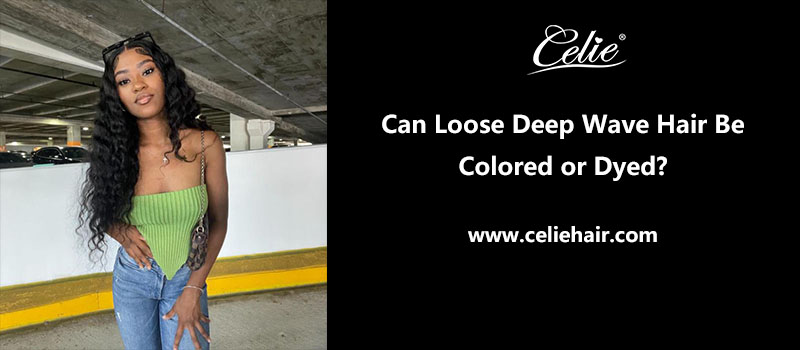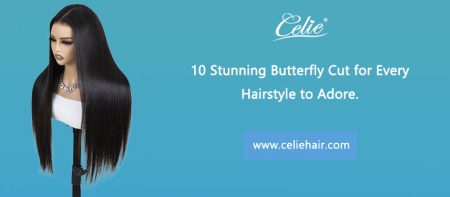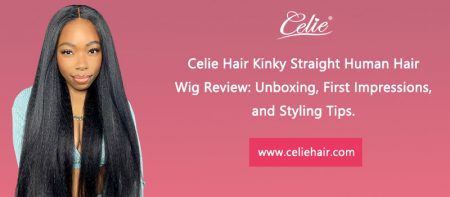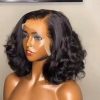When it comes to hair, the possibilities for personalization and creativity are endless. From different cuts and styles to various hair colors, individuals have the freedom to experiment with their hair to reflect their unique personalities and preferences. Loose deep wave hair, with its beautiful curls and waves, is a popular choice for many. However, a common question that arises is whether loose deep wave hair can be colored or dyed. In this comprehensive guide, we will delve into the world of loose deep wave hair, exploring its characteristics, the coloring process, and crucial considerations to keep in mind.
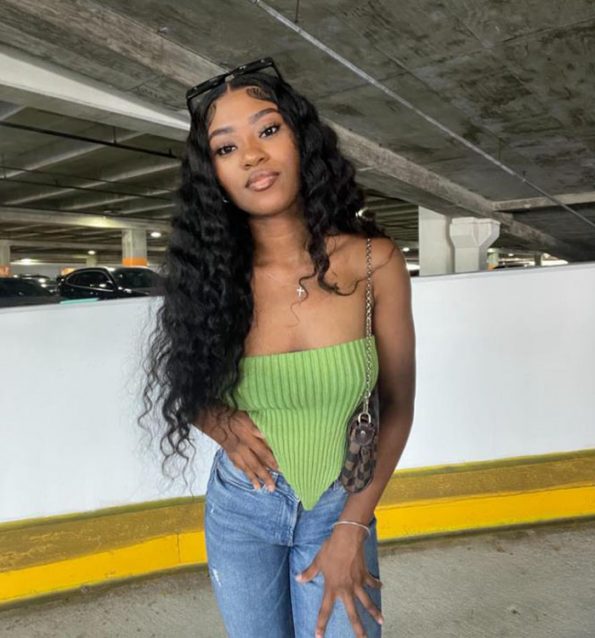
Coloring Loose Deep Wave Hair: An Overview.
When it comes to personalizing your hair, coloring is a popular option that allows you to express your individuality and style. However, before embarking on the journey of coloring your loose deep wave hair, it’s important to understand the process, considerations, and potential outcomes involved. In this section, we will provide an overview of coloring loose deep wave hair, including the difference between professional coloring and at-home coloring, as well as tips for choosing the right color.
Professional Coloring vs. At-Home Coloring:
Coloring your hair can be done either by a professional hair stylist or as a DIY project at home. Each option has its own pros and cons:
Professional Coloring:
Expertise: Professional hair stylists have the knowledge, skills, and experience to achieve the desired color while minimizing damage to the hair.
Customization: A professional stylist can assess your hair type, texture, and condition to recommend the most suitable coloring techniques and products for your loose deep wave hair.
Complex Coloring Techniques: If you desire complex color transformations, such as highlights, balayage, or ombré, a professional colorist can execute these techniques with precision.
At-Home Coloring:
Cost-Effective: Coloring your hair at home is generally more affordable than visiting a salon or stylist.
Convenience: You can dye your hair at your own pace and in the comfort of your home.
Limited Expertise: Unless you have experience or knowledge in hair coloring, achieving the desired results can be challenging, and there is a higher risk of damaging your hair.
Limited Color Options: At-home hair coloring kits may have a more limited range of colors compared to professional salon products.
Choosing the Right Color:
Selecting the right color for your loose deep wave hair is crucial in achieving your desired outcome. Consider the following factors:
Skin Tone: Your skin tone plays a significant role in determining which hair colors will complement your complexion. Generally, warm-toned skin pairs well with warm shades like golden browns, copper, or auburn, while cool-toned skin suits cooler shades such as ash browns or cool blondes. If you’re unsure, consult with a professional colorist for personalized advice.
Personal Style: Think about the overall look you want to achieve. Do you prefer a subtle change that enhances your natural hair color, or are you looking for a bold and dramatic transformation? Consider your lifestyle, fashion choices, and personal preferences when choosing a color that aligns with your style.
Maintenance: Different hair colors require varying levels of maintenance. Lighter shades may require more frequent touch-ups to maintain the desired color, while darker shades tend to be more low-maintenance. Consider the time and effort you’re willing to invest in maintaining your colored loose deep wave hair.
Compatibility with Hair Type: Some hair types are more susceptible to damage from coloring treatments. If you have previously chemically treated or damaged hair, it is essential to consult with a professional colorist to assess the health of your hair and determine the best approach to achieve your desired color while minimizing further damage.
Preparing Loose Deep Wave Hair for Coloring:
Before coloring your loose deep wave hair, it is crucial to prepare it properly to achieve the best results. Consider the following steps:
Hair Health and Condition: Ensure that your hair is in optimal health before applying any color. Deep condition your hair regularly in the weeks leading up to the coloring process to nourish and strengthen it. Healthy hair is more likely to hold color evenly and result in a more vibrant outcome.
Strand Testing: Perform a strand test to preview how your loose deep wave hair will react to the chosen color. This test involves applying color to a small section of hair to observe the resulting shade and ensure it aligns with yourdesired outcome. It also helps identify any potential allergic reactions or adverse effects before applying the color to your entire head of hair.
Pre-Coloring Treatment: If your loose deep wave hair is dry or damaged, consider a pre-coloring treatment to improve its condition and enhance color absorption. This treatment may involve using hair masks, protein treatments, or specialized products recommended by a professional stylist.
By taking the time to prepare your loose deep wave hair adequately, you can ensure that it is in the best possible condition to receive and retain the color effectively.
Preparing Loose Deep Wave Hair for Coloring.
Before embarking on the process of coloring your loose deep wave hair, it is crucial to prepare it properly. Adequate preparation ensures that your hair is in the best possible condition to receive and retain the color effectively. Here are some essential steps to follow when preparing your loose deep wave hair for coloring:
Assess Hair Health and Condition:
Before coloring your hair, it is essential to evaluate its current health and condition. If your hair is already damaged, weak, or excessively dry, it may not be the ideal time to introduce color. Coloring damaged hair can further compromise its integrity and result in undesired outcomes. In such cases, it is recommended to focus on restoring the health of your hair through deep conditioning treatments, protein treatments, and regular moisturizing routines. Once your hair is in a healthier state, it will be better prepared for the coloring process.
Deep Conditioning Treatments:
Deep conditioning treatments play a vital role in nourishing and moisturizing your hair, ensuring it is adequately hydrated before coloring. Use a deep conditioning mask or treatment that is specifically formulated for curly or textured hair. Look for products that contain ingredients like shea butter, coconut oil, or argan oil, as they provide deep hydration and help improve the elasticity and overall condition of your hair. Perform deep conditioning treatments regularly in the weeks leading up to the coloring process to maximize moisture retention and enhance color absorption.
Avoid Chemical Treatments:
Avoid chemical treatments such as relaxers, perms, or other harsh treatments for a significant period before coloring your loose deep wave hair. Chemical treatments can weaken the hair structure and make it more susceptible to damage during the coloring process. Allow your hair to rest and recover from any previous chemical processes, giving it time to regain its natural strength and resilience.
Conduct a Strand Test:
Performing a strand test is a crucial step in preparing for hair coloring. This test involves applying a small amount of the chosen hair color or dye to a discreet section of hair, typically from the back or underneath, and monitoring the results. The strand test allows you to observe how your loose deep wave hair reacts to the color and assesses the final shade achieved. It also helps you determine the processing time required to achieve your desired color intensity. By conducting a strand test, you can avoid unexpected color outcomes and make any necessary adjustments before proceeding with coloring your entire head of hair.
Clarify and Remove Buildup:
Before coloring, it is important to clarify your hair and remove any product buildup or residue. Over time, styling products, oils, and environmental pollutants can accumulate on the hair, creating a barrier that inhibits proper color penetration. Use a clarifying shampoo or a gentle sulfate-free shampoo to cleanse your hair thoroughly and remove any buildup. This will create a clean canvas for the color to adhere to and ensure even color distribution.
Protect Your Scalp:
Apply a thin layer of petroleum jelly or a protective barrier cream around your hairline, ears, and neck to prevent the color from staining your skin. This step will make the cleanup process easier and minimize the risk of skin irritation or discoloration.
The Coloring Process for Loose Deep Wave Hair.
Once you have adequately prepared your loose deep wave hair for coloring, it’s time to dive into the actual coloring process. Whether you choose to visit a professional hair stylist or opt for an at-home coloring experience, understanding the step-by-step process will help you achieve the desired results. Here is a general guide to the coloring process for loose deep wave hair:
Gather the Necessary Supplies:
Before you begin, make sure you have all the supplies you need for the coloring process. This includes hair color or dye, developer, gloves, a mixing bowl, an applicator brush or bottle, clips to section your hair, and towels or capes to protect your clothing and surroundings.
Follow the Instructions:
Carefully read and follow the instructions provided with your chosen hair color or dye. These instructions will provide specific details on how to mix the color and developer, as well as the recommended processing time for achieving optimal results. Different brands and types of hair color may have variations in application and processing methods, so it’s important to follow the instructions provided.
Section Your Hair:
Divide your loose deep wave hair into manageable sections using clips. This will make the coloring process more organized and ensure that all sections are evenly covered with color. Start with the bottom sections and work your way up to the top layers, gradually releasing and coloring each section.
Apply the Color:
Using either an applicator brush or bottle, apply the hair color or dye to each section of your loose deep wave hair. Begin at the roots and work your way down to the ends, ensuring that the color is evenly distributed. Take care to saturate each strand, paying attention to the curls and waves, to achieve consistent color throughout your hair.
Process the Color:
Once you have applied the color, follow the recommended processing time specified in the instructions. This is the time required for the color to develop and penetrate the hair shaft. It is crucial to adhere to the processing time to avoid under- or over-processing, which can affect the color result and hair health. Set a timer to ensure accurate timing.
Rinse and Condition:
After the processing time is complete, rinse your loose deep wave hair thoroughly with lukewarm water until the water runs clear. Be gentle to avoid disrupting the curl pattern or causing excessive tangling. Once the color has been rinsed out, apply a color-safe conditioner to help restore moisture and maintain the vibrancy of the color. Leave the conditioner on for the recommended time before rinsing it out.
Post-Coloring Care:
After coloring your loose deep wave hair, it is essential to implement a post-coloring care routine to maintain the health and vibrancy of your hair. This includes using color-safe and sulfate-free shampoos and conditioners specifically formulated for colored hair. Additionally, incorporating deep conditioning treatments and regular moisturizing will help keep your hair hydrated and prevent color fade.
Maintenance and Care Tips for Colored Loose Deep Wave Hair.
Colored loose deep wave hair requires special attention and care to maintain its vibrancy, health, and curl pattern. By following these maintenance and care tips, you can prolong the life of your color and keep your loose deep wave hair looking its best:
Use Color-Safe Haircare Products:
Invest in color-safe shampoos, conditioners, and styling products specifically formulated for colored hair. These products are designed to be gentle and preserve the vibrancy of your color. Look for sulfate-free formulas that won’t strip away the color or moisture from your hair. Additionally, opt for products that provide hydration and nourishment to keep your hair healthy and prevent dryness.
Limit Washing and Use Cold Water:
Frequent washing can cause color to fade more quickly. Try to limit washing your loose deep wave hair to two or three times a week, or even less if possible. When washing, use cold or lukewarm water as hot water can strip away color and dry out your hair. Rinse your hair thoroughly to ensure all product residues are removed.
Deep Condition Regularly:
Deep conditioning treatments are crucial for colored loose deep wave hair. They help restore moisture, repair damage, and maintain the health of your hair. Use deep conditioning masks or treatments specifically formulated for colored hair once or twice a week. Apply the treatment from mid-length to the ends of your hair, focusing on the areas that may be drier or more damaged.
Protect Your Hair from Heat:
Excessive heat styling can cause damage to your hair and accelerate color fading. Minimize the use of heat styling tools such as flat irons, curling irons, and blow dryers. If you do use heat, apply a heat protectant spray or serum to shield your hair from damage. Consider embracing natural air-drying or using heat-free styling methods to preserve your color and curls.
Avoid Excessive Sun Exposure:
Prolonged exposure to the sun’s UV rays can cause color fading and dryness in your loose deep wave hair. Protect your hair by wearing a hat, scarf, or using UV-protective hair products when spending extended periods in the sun. This will help shield your color from UV damage and maintain its vibrancy.
Minimize Chemical Treatments:
Chemical treatments, such as relaxers, perms, and additional coloring, can further damage your hair and compromise the integrity of your color. Minimize or avoid these treatments, especially in the first few weeks after coloring your loose deep wave hair. If you must undergo a chemical treatment, consult a professional stylist who specializes in colored hair and understands how to minimize the impact on your color and hair health.
Avoid Chlorine and Saltwater:
Chlorine and saltwater can be damaging to your colored hair and cause it to become dry and brittle. Before swimming in a pool, protect your hair by wetting it with clean water and applying a leave-in conditioner or hair oil. This creates a barrier and prevents your hair from absorbing as much chlorine. After swimming, rinse your hair thoroughly with clean water to remove any residual chlorine or salt.
Regular Trims:
Regular trims are essential for maintaining the health and shape of your loose deep wave hair. Trimming removes split ends and prevents them from traveling up the hair shaft, leading to more significant damage. Aim for regular trims every 6 to 8 weeks to keep your hair looking fresh and healthy.
Potential Challenges and Risks of Coloring Loose Deep Wave Hair.
While coloring your loose deep wave hair can be an exciting and transformative experience, it’s important to be aware of the potential challenges and risks that may arise. Understanding these factors can help you make informed decisions and take appropriate precautions during the coloring process. Here are some potential challenges and risks to consider:
Damage and Hair Integrity:
Coloring processes, particularly those involving bleaching or lightening, can be harsh on the hair. These processes can strip the hair of its natural moisture, leading to dryness, breakage, and loss of curl pattern. The more drastic the color change, the higher the risk of damage. It’s crucial to assess the health of your hair before coloring and ensure it is in good condition to withstand the coloring process. Deep conditioning treatments, protein treatments, and regular hair care practices can help maintain hair health and minimize the risk of damage.
Color Results on Different Hair Types:
Color results can vary depending on your hair type and texture. Loose deep wave hair tends to have a more porous structure, which can affect how color is absorbed and retained. Colors may appear slightly different on textured hair compared to straight hair. It’s important to consider these factors when choosing a color and to consult with a professional colorist who has experience working with textured hair. They can provide guidance on achievable results and help you select the best coloring techniques and products for your specific hair type.
Color Fading and Maintenance:
Colored hair, including loose deep wave hair, is susceptible to color fading over time, especially if not properly maintained. Factors such as sun exposure, heat styling, frequent washing, and using harsh hair care products can contribute to color fading. To minimize color fade, follow a hair care routine specifically designed for colored hair, including using color-safe products, limiting heat styling, protecting your hair from UV rays, and avoiding excessive washing. Regular color touch-ups may also be necessary to maintain the vibrancy of your color.
Uneven Color Distribution:
Due to the textured nature of loose deep wave hair, achieving even color distribution throughout the hair can be challenging. Curls and waves can make it difficult for the color to reach every strand uniformly. It’s important to work in small sections, saturating each strand thoroughly and paying extra attention to the curl pattern. Additionally, consider seeking professional assistance for coloring your loose deep wave hair, as experienced colorists have techniques to ensure even color distribution and minimize any patchiness.
Allergic Reactions:
Some individuals may experience allergic reactions or sensitivities to hair color products. Before applying any color or dye to your hair, it’s crucial to perform a patch test to check for any adverse reactions. Apply a small amount of the product to a small area of skin, typically behind the ear or on the inner arm, and monitor for any signs of irritation or allergic reactions for at least 24 hours. If you experience any negative reactions, such as itching, redness, or swelling, avoid using the product and consult a healthcare professional.
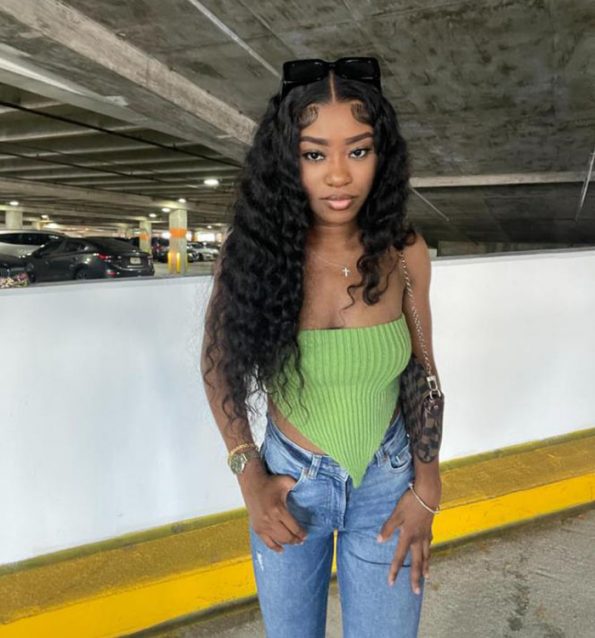
Professional Assistance: Seeking a Hair Stylist for Coloring Loose Deep Wave Hair.
When it comes to coloring your loose deep wave hair, seeking the expertise of a professional hair stylist can be a valuable decision. Professional stylists specialize in hair coloring techniques and have the knowledge, skills, and experience necessary to achieve optimal results while minimizing the risks and challenges associated with coloring. Here are some key points to consider when seeking a hair stylist for coloring your loose deep wave hair:
Research and Recommendations:
Start by conducting thorough research to find reputable hair salons or stylists in your area. Seek recommendations from friends, family, or colleagues who have had positive experiences with professional hair coloring. Online reviews and testimonials can also provide insights into the skills and expertise of various stylists.
Specialization in Textured Hair:
Look for a hair stylist who specializes in working with textured hair, particularly loose deep wave hair. They will have a deep understanding of the unique characteristics and needs of textured hair, including how it reacts to different coloring techniques and products. A specialist in textured hair will be better equipped to achieve your desired color while preserving the health and integrity of your curls.
Portfolio and Consultations:
When considering a hair stylist, review their portfolio or online gallery to assess their previous work with textured hair and coloring. Look for examples of clients with loose deep wave hair to gauge their skill in achieving vibrant, well-blended color on similar hair types. Schedule consultations with potential stylists to discuss your desired color, concerns, and expectations. This will allow you to assess their communication skills, expertise, and compatibility with your vision.
Clear Communication:
During the consultation, ensure there is clear communication between you and the stylist. Explain your desired color, any specific concerns or limitations, and your overall vision for your loose deep wave hair. A skilled stylist will listen attentively, ask relevant questions, and provide professional advice on achieving your goals while considering the health and integrity of your hair.
Expert Color Recommendations:
A professional hair stylist will be able to guide you in selecting the most suitable color for your loose deep wave hair. Based on your skin tone, hair type, and desired outcome, they can offer expert recommendations on shades and coloring techniques that will complement your features and align with your personal style.
Execution of Coloring Techniques:
One of the advantages of working with a professional stylist is their expertise in executing various coloring techniques. Whether you desire highlights, balayage, ombré, or a full-color transformation, a skilled stylist can apply these techniques with precision and achieve seamless, natural-looking results on your loose deep wave hair.
Post-Coloring Maintenance Advice:
A professional stylist will provide you with personalized advice on how to maintain your colored loose deep wave hair after the salon visit. They can recommend specific hair care products, suggest a customized hair care routine, and provide tips on maintaining color vibrancy and hair health between salon visits.

